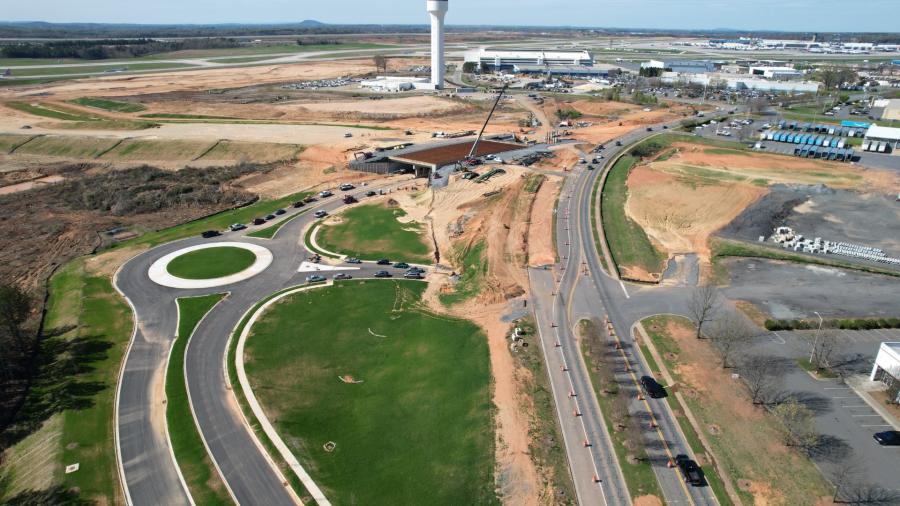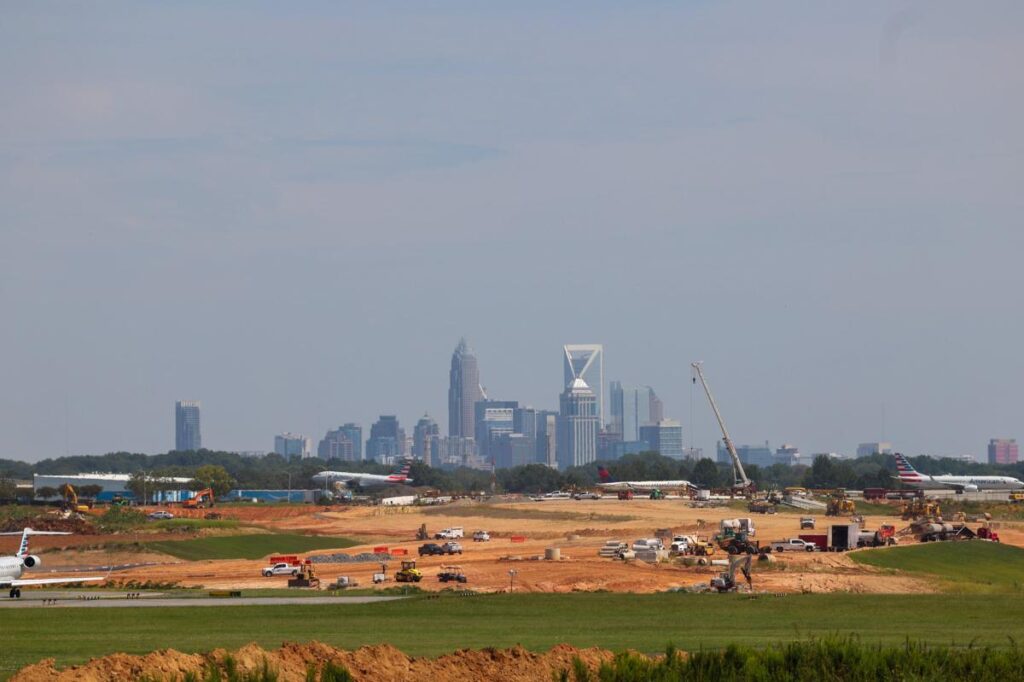The timetable for completion is “comfortably aggressive” because design and construction teams understand what needs to be accomplished to hit their targets.
(Charlotte Airport photo)
Charlotte Douglas International Airport (CLT) in North Carolina’s largest city is embarking on yet another in a long series of infrastructure projects designed to address its capacity and meet future demand while enhancing its operational efficiency.
Located 6 mi. west of uptown Charlotte, the 6,000-acre airport complex offers nonstop air service to 179 destinations around the world and is home to eight major air carriers, 15 regional airlines and three foreign carriers, according to airport officials.
It also has gained status as the second largest of American Airlines’ 10 hubs, after Dallas/Fort Worth.
The centerpiece of the latest effort in Charlotte’s Destination CLT portfolio, which has been building a range of expansive projects at the complex for most of the last decade, is the construction of the airport’s fourth parallel runway, a 10,000-ft.-long, 150-ft.-wide surface for departing air traffic.
According to Jack Christine, the airport’s chief infrastructure officer, work also is progressing on an extension of a north end-around taxiway, the relocation of two roadways to accommodate the project, the building of Overlook, a nearby public park that affords visitors a close-up view of aircraft takeoffs and landings.
Another project is the construction of a new south-end cross-field taxiway with a bridge for airliners to taxi over a city street. The runway project also will include building a new electrical lighting vault, and an additional fire station.
Taken together, these projects all have a price tag of just more than $1.4 billion.
Runway Requires Mass Grading
Christine said that mass grading got under way in June on the new Runway 1-19 at a site between two existing runways, 18C/36C to the east, and 18R/36L to the west, all of which are west of the CLT terminal. The facility’s other runway, 18L/36R, is in service on the east side of the terminal.
“The far-western runway is for landings and Runway 1-19 next to it will be for departures,” Christine noted, adding that the Runway 18C/36C is for arrivals and takeoffs, but will be used solely for landings once the new one is open.
“Overall, the contractors will need to move six million cubic yards of dirt, meaning that the longest duration of work in the program is the grading,” he continued. “So, we have initiated a mass-grading contract to help us get started on that in order to help us meet the new runway’s commissioning date of September 2027.

He called the timetable for completion “comfortably aggressive” because his design and construction teams understand what needs to be accomplished to hit their targets.
“It is doable, but to make it work, we had to break up the project by starting the grading early while we are still in the design for the final grading and paving for the project,” he said.
Excavators, bulldozers and wheel loaders are operated by D.S. Wagner Co., an experienced Ohio-based contractor who has the contract for the huge grading effort.
The runway’s length on its southern end is such that crews have had to relocate a small portion of West Boulevard to allow for heavy equipment to do their work.
Once the mass grading is complete, Christine noted, there will be a series of additional contracts issued for the fine grading, as well as the paving and lighting for each of the other components of the project.
Later, he estimates 600,000 cu. yds. of concrete will be placed during the bulk of the runway construction from late next year through mid-2027.
Airport Experiences Rapid Growth
Christine explained the planned Runway 1-19 is needed due to the non-stop growth of flights to and from CLT, which has transformed it from a regional airport decades ago into one of the world’s busiest.
In 2022, for instance, Charlotte Douglas recorded approximately 47.8 million passengers flying in and out of the airport, making it the seventh-most active in North America, according to Airports Council International (ACI). CLT’s passenger traffic last year ranked 19th in the world.
“That growth is putting increased pressure on the airfield to be able to keep up,” Christine said. “Currently, we are seeing an average delay of about 12 minutes per aircraft. From a planning perspective, if you have more than four minutes of delay, then your airfield is constrained, so we are well beyond the need for an additional runway to help deal with the volume of traffic that we have in Charlotte.”
He explained that the new construction will allow CLT to separate arrivals and departures on the center runway set, which increases the capacity for the airfield overall and the airspace that the planes operate in, making it integral the new runway is completed in the next four years.
New Taxiways Will Improve Flow
No less important than the new runway is the construction of the two newest taxiways, without which the former would be nothing more than a wide road to nowhere.
“The north end-around taxiway is being constructed to allow the aircraft that land out at Runway 18R-36L to taxi around the parallel center runway without crossing it,” Christine said. “We have about 550,000 operations a year and over 150,000 of them land on that western parallel runway. Right now, every single one of them must cross over our center runway, so that particular taxiway project will give us the ability to flow those aircraft safely onto the air carrier ramp without crossing a runway.”
That also will reduce aircraft operating time, fuel burn and emissions while cutting the long wait times for passengers anxious to get to their gates.
“The north end-around taxiway project is a massive project in and of itself,” said Christine. “And it is really a precursor to the runway program.”
To accommodate the north taxiway construction, crews also relocated two portions of Old Dowd Road a bit to the north, where a new bridge for the street will be built over the Norfolk Southern mainline. Multiple utilities also needed to be relocated, including a large water line, and one of the major lines that pumps fuel from a depot several miles away into the airport’s fuel pond.
“We are now about to start paving the taxiway itself and will go as far into the colder months as we can before coming back in the next paving season to complete it and get the taxiway ready to open,” Christine said. “Additionally, the navigational aids for Runway 18-C have been relocated and we have turned them over to the [Federal Aviation Administration].”
Hi-Way Paving of Ohio is taking care of the hard-surface work.
Taxiway to Come With New Bridge
Less than 2 mi. to the south, Charlotte’s new south cross-field taxiway will utilize a bridge to allow aircraft to pass over Yorkmont Road at that end of the airfield, according to Christine.
“That bridge is under construction right now, and Yorkmont Road will relocate underneath that overpass in the next couple months so we may close the existing street to let the contractors finish the taxiway grading,” he noted.
To accommodate wide and heavy airliners and cargo jets, the bridge’s length is 106-ft.-6-in., with a width of 220 ft.
Construction crews anchored it into the ground by driving 244 H-piles, totaling 18,000 longitudinal ft.
In addition, the bridge’s construction will require:
- 2 million lbs. of structural steel.
- 74 equal angle (EA) 4-ft.-6-in.-tall, 101-ft-long steel girders.
Its substructure (the footings, columns, and caps) will include:
- Reinforcing steel weighing 1.2 million lbs.
- A total of 3,700 cu. yds. of concrete.
The 23,103-sq.-ft. bridge deck slab will need:
- 1,000 cu. yds. of concrete, installed in six separate pours.
- Reinforcing steel weighing 413,500 lbs.
The structure’s approach slabs will encompass:
- 15,930 sq. ft.
- 1,500 cu. yds. of concrete.
- Reinforcing steel that tips the scales at 524,000 lbs.
The bridge also will be designed to Airplane Design Group (ADG) V specifications, according to Charlotte Douglas, with live loads equaling 1.5 million lbs. for an aircraft with two main landing gear assemblies, each carrying 50 percent of aircraft gross weight, neglecting the nose gear.
Christine added that the airport’s newest fire station is planned for the south end of the complex, as well, adjacent to the cross-field taxiway currently under construction.
Popular Overlook Returning to Airport
Another component of the current Destination CLT enterprise is the rebuilding and relocation of Charlotte Douglas International’s popular Overlook, a place where folks have long enjoyed excellent views of airplanes taking off, landing and taxiing across the tarmac.
For 30 years, Christine said, the Overlook had been a favorite stop for visitors to the airport complex.
But with the construction of the north end-around taxiway, airport planners needed to move the vantage point further to the west from its original location. When the new Overlook is open, visitors will be able to get a wider look of the western parallel runway, the fourth parallel runway when it opens, as well as a good part of the new north taxiway.
“We are very excited about that part of the project,” Christine explained.
The updated Overlook will include a kids’ playground, family picnic areas, a place for food trucks, restrooms and a static display aircraft. It will also be adjacent to the already-in-place memorial to the victims of USAir Flight 1016, which crashed during a heavy thunderstorm as it approached Runway 18C in July 1994.
Schedule Adjustment Saves Time, Money
Because of how well Christine and his team of professionals have planned the new runway/taxiway project at Charlotte Douglas, he is confident that they have identified all potential challenges and developed effective solutions to them.
“As I mentioned earlier, getting the grading contract started while we are doing the design has proved to be a key mitigation for how long it would take to build the runway,” he said. “Based on our benefit-cost analysis, that runway will save the airline industry $250 million a year, so every year it is not open is a big miss on our part. The first schedule that we had showed the runway commissioning in 2029 and we realized that we could not go that long without it. It was very sequential and did not call for any paving to start until after all the grading was done.
“So, we went back and took a new look at the schedule, and now we are on a path that gets that runway opening two years earlier.” CEG
Read the full article here

